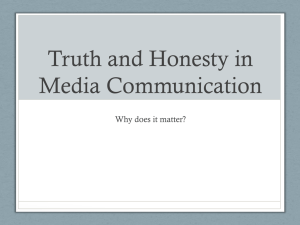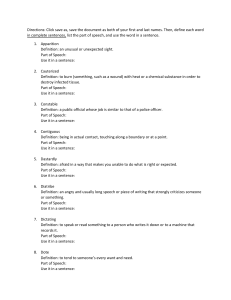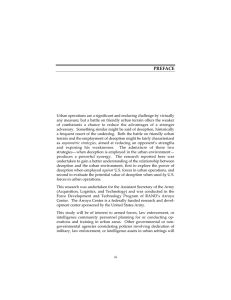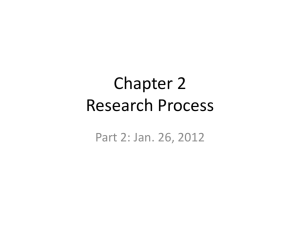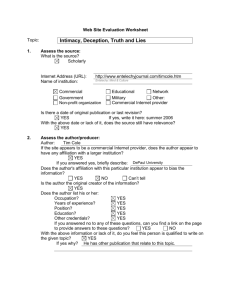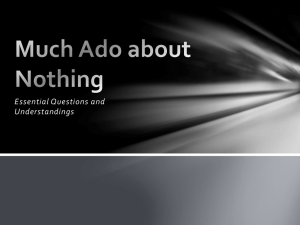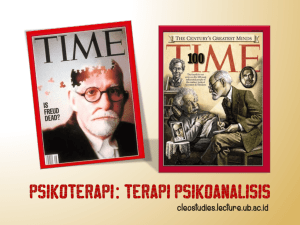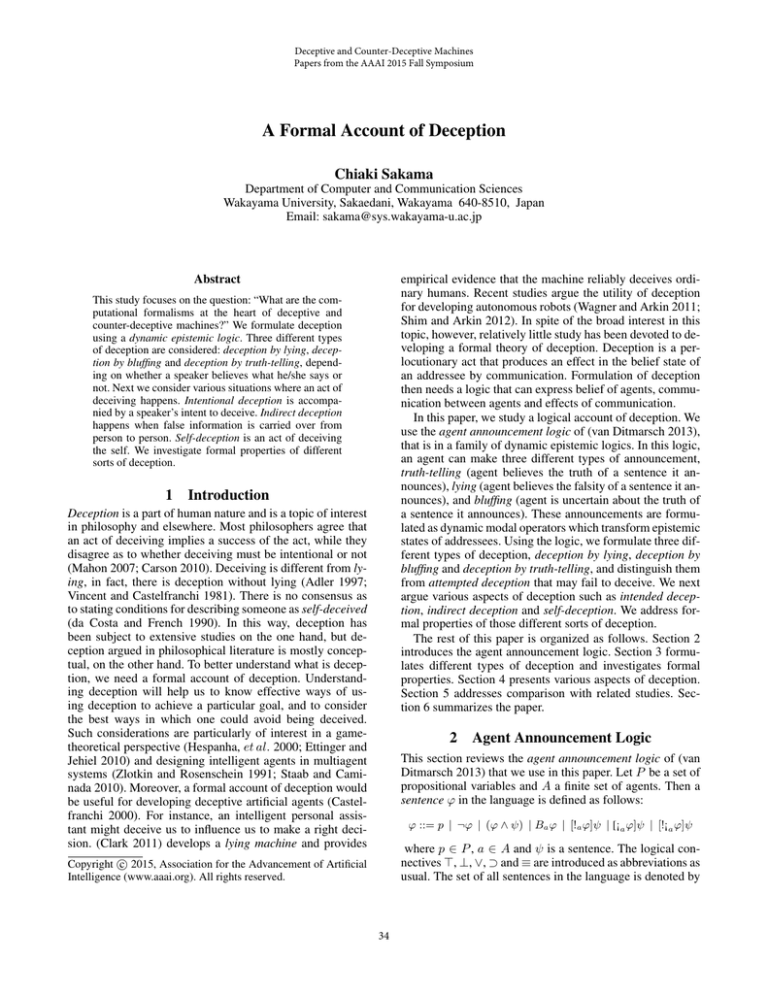
Deceptive and Counter-Deceptive Machines
Papers from the AAAI 2015 Fall Symposium
A Formal Account of Deception
Chiaki Sakama
Department of Computer and Communication Sciences
Wakayama University, Sakaedani, Wakayama 640-8510, Japan
Email: sakama@sys.wakayama-u.ac.jp
Abstract
empirical evidence that the machine reliably deceives ordinary humans. Recent studies argue the utility of deception
for developing autonomous robots (Wagner and Arkin 2011;
Shim and Arkin 2012). In spite of the broad interest in this
topic, however, relatively little study has been devoted to developing a formal theory of deception. Deception is a perlocutionary act that produces an effect in the belief state of
an addressee by communication. Formulation of deception
then needs a logic that can express belief of agents, communication between agents and effects of communication.
In this paper, we study a logical account of deception. We
use the agent announcement logic of (van Ditmarsch 2013),
that is in a family of dynamic epistemic logics. In this logic,
an agent can make three different types of announcement,
truth-telling (agent believes the truth of a sentence it announces), lying (agent believes the falsity of a sentence it announces), and bluffing (agent is uncertain about the truth of
a sentence it announces). These announcements are formulated as dynamic modal operators which transform epistemic
states of addressees. Using the logic, we formulate three different types of deception, deception by lying, deception by
bluffing and deception by truth-telling, and distinguish them
from attempted deception that may fail to deceive. We next
argue various aspects of deception such as intended deception, indirect deception and self-deception. We address formal properties of those different sorts of deception.
The rest of this paper is organized as follows. Section 2
introduces the agent announcement logic. Section 3 formulates different types of deception and investigates formal
properties. Section 4 presents various aspects of deception.
Section 5 addresses comparison with related studies. Section 6 summarizes the paper.
This study focuses on the question: “What are the computational formalisms at the heart of deceptive and
counter-deceptive machines?” We formulate deception
using a dynamic epistemic logic. Three different types
of deception are considered: deception by lying, deception by bluffing and deception by truth-telling, depending on whether a speaker believes what he/she says or
not. Next we consider various situations where an act of
deceiving happens. Intentional deception is accompanied by a speaker’s intent to deceive. Indirect deception
happens when false information is carried over from
person to person. Self-deception is an act of deceiving
the self. We investigate formal properties of different
sorts of deception.
1
Introduction
Deception is a part of human nature and is a topic of interest
in philosophy and elsewhere. Most philosophers agree that
an act of deceiving implies a success of the act, while they
disagree as to whether deceiving must be intentional or not
(Mahon 2007; Carson 2010). Deceiving is different from lying, in fact, there is deception without lying (Adler 1997;
Vincent and Castelfranchi 1981). There is no consensus as
to stating conditions for describing someone as self-deceived
(da Costa and French 1990). In this way, deception has
been subject to extensive studies on the one hand, but deception argued in philosophical literature is mostly conceptual, on the other hand. To better understand what is deception, we need a formal account of deception. Understanding deception will help us to know effective ways of using deception to achieve a particular goal, and to consider
the best ways in which one could avoid being deceived.
Such considerations are particularly of interest in a gametheoretical perspective (Hespanha, et al. 2000; Ettinger and
Jehiel 2010) and designing intelligent agents in multiagent
systems (Zlotkin and Rosenschein 1991; Staab and Caminada 2010). Moreover, a formal account of deception would
be useful for developing deceptive artificial agents (Castelfranchi 2000). For instance, an intelligent personal assistant might deceive us to influence us to make a right decision. (Clark 2011) develops a lying machine and provides
2
Agent Announcement Logic
This section reviews the agent announcement logic of (van
Ditmarsch 2013) that we use in this paper. Let P be a set of
propositional variables and A a finite set of agents. Then a
sentence ϕ in the language is defined as follows:
ϕ ::= p | ¬ϕ | (ϕ ∧ ψ) | Ba ϕ | [!a ϕ]ψ | [¡a ϕ]ψ | [!¡a ϕ]ψ
where p ∈ P , a ∈ A and ψ is a sentence. The logical connectives >, ⊥, ∨, ⊃ and ≡ are introduced as abbreviations as
usual. The set of all sentences in the language is denoted by
c 2015, Association for the Advancement of Artificial
Copyright Intelligence (www.aaai.org). All rights reserved.
34
Φ. Throughout the paper, lower case letters a, b, c, . . . represent agents in A and Greek letters λ, ϕ, ψ represent sentences in Φ unless otherwise stated. A sentence Ba ϕ is read
as “an agent a believes ϕ.” The operators [!a ϕ], [¡a ϕ] and
[!¡a ϕ] respectively stand for “a truthfully announces ϕ”, “a
is lying that ϕ”, and “a is bluffing that ϕ”, where an agent a
addresses a sentence ϕ to another agent. Using these operators, we read that
• [!a ϕ]ψ: ψ is true after a’s truthful announcement of ϕ
• [¡a ϕ]ψ: ψ is true after a’s lying announcement of ϕ
• [!¡a ϕ]ψ: ψ is true after a’s bluffing announcement of ϕ.
The semantics is given by the Kripke structure. An epistemic model is a triple M = (S, R, V ) where S is a nonempty set of possible worlds, R : A → P(S×S) is an accessibility function (written Ra for a ∈ A), and V : S → P(P )
is a valuation function (Vp represents the set of worlds where
p is true). An epistemic state (M, s) for s ∈ S satisfies sentences as follows:
(A4)
(A5)
(A6)
where Maϕ is as M except for the accessibility relation R0
that is defined over S such that Ra0 := Ra and Rb0 := Rb ∩
(S × [[Ba ϕ]]M ) for b ∈ A (a 6= b) where [[ϕ]]M := {s ∈
S | M, s |= ϕ}. A sentence ϕ is true in a model M (written
M |= ϕ) iff M, s |= ϕ for any s ∈ S. ϕ is valid iff M |= ϕ
for any model M .
An agent a may address a sentence ϕ no matter what,
whether she believes what she says, believes the opposite,
or is uncertain. The situation is represented as the precondition Ba ϕ for a’s truthful announcement, Ba ¬ϕ for a’s lying
announcement, and ¬ (Ba ϕ ∨ Ba ¬ϕ) for a’s bluffing announcement. Throughout the paper, agents are assumed to
have the K45 axioms for the belief operator B: (distribution) Ba (ϕ ⊃ ψ) ⊃ (Ba ϕ ⊃ Ba ψ); (positive introspection) Ba ϕ ⊃ Ba Ba ϕ; (negative introspection) ¬Ba ϕ ⊃
Ba ¬Ba ϕ, and inference rules: (modus ponens) ϕ ϕ⊃ψ
and
ψ
(necessitation) Bϕa ϕ . An agent who has the additional Daxiom ¬Ba ⊥ is called a KD45 agent. A theorem is a formula
that is obtained from axiom instances via the inference rules.
We write ` ϕ iff a sentence ϕ is a theorem of the logic.
In this paper, we consider communication between two
agents. Let a be an agent who makes an announcement
(called a speaker), and b an agent who is an addressee (called
a hearer). The axioms for the belief consequences of agent
communication are given as follows.
[!a ϕ]Ba ψ ≡
[¡a ϕ]Ba ψ ≡
[!¡a ϕ]Ba ψ ≡
≡
≡
≡
Ba ϕ ⊃ Bb [!a ϕ]ψ
Ba ¬ϕ ⊃ Bb [!a ϕ]ψ
¬(Ba ϕ ∨ Ba ¬ϕ) ⊃ Bb [!a ϕ]ψ
By (A1)–(A3), the speaker a recognizes his/her act of truthtelling, lying, or bluffing. By (A4)–(A6), on the other hand,
the hearer b believes that the speaker always make a truthful announcement. (A1)–(A6) hold by replacing Ba ψ (resp.
Bb ψ) with ¬Ba ψ (resp. ¬Bb ψ) on the left of ≡ and replacing Ba [. . .]ψ (resp. Bb [. . .]ψ) with ¬Ba [. . .]ψ (resp.
¬Bb [. . .]ψ) on the right of ≡. This axiomatization characterizes a credulous addressee in the sense that a hearer always
believes that a speaker is sincere (i.e., a hearer believes that
a speaker believes the announcement). On the other hand,
the agent announcement logic can also characterize skeptical agents who can distinguish believable announcement
(¬Bb ¬Ba ϕ) from unbelievable one (Bb ¬Ba ϕ). In this case,
a skeptical addressee only incorporates new information if
the addressee considers it possible that a speaker believes
that the announced sentence is true. The logic also has a
variant for belief revising agents in which an agent believes
everything that it is told by consistently revising its current
possibly conflicting beliefs. Belief revising agents as well as
skeptical agents have axiomatizations different from those
for credulous addressees. In this paper, we consider credulous addressees unless stated otherwise. This is because deception usually happens when an addressee credulously believes that a speaker is truthful. The axiomatic system for
credulous agents is sound and complete for K45, while it
is incomplete for KD45. By contrast, the axiomatic system
for skeptical agents is also complete for KD45. We provide
some valid formulas that will be used in this paper.
M, s |= p iff s ∈ Vp
M, s |= ¬ϕ iff M, s 6|= ϕ
M, s |= ϕ ∧ ψ iff M, s |= ϕ and M, s |= ψ
M, s |= Ba ϕ iff ∀t ∈ S : Ra (s, t) implies M, t |= ϕ
M, s |= [!a ϕ]ψ iff M, s |= Ba ϕ implies Maϕ , s |= ψ
M, s |= [¡a ϕ]ψ iff M, s |= Ba ¬ϕ implies Maϕ , s |= ψ
M, s |= [!¡a ϕ]ψ iff M, s |= ¬ (Ba ϕ ∨ Ba ¬ϕ)
implies Maϕ , s |= ψ
(A1)
(A2)
(A3)
[!a ϕ]Bb ψ
[¡a ϕ]Bb ψ
[!¡a ϕ]Bb ψ
Proposition 2.1 (van Ditmarsch 2013) Let p, q ∈ P be
propositional variables.
(i) Ba [!a p]q ≡ Ba [!¡a p]q ≡ Ba [¡a p]q ≡ Ba q.
(ii) [!a p]Bb Ba p ≡ [!¡a p]Bb Ba p ≡ [¡a p]Bb Ba p ≡ >.
Proposition 2.1 does not hold for arbitrary sentences in
general.
3
3.1
Deception in Agent Announcement Logic
Deception by Lying
Deception is different from lying. Carson (2010) says: “unlike ‘lying’ the word ‘deception’ connotes success. An act
must actually mislead someone (cause someone to have false
beliefs) if it is to count as a case of deception. Many lies are
not believed and do not succeed in deceiving anyone” (Carson 2010, p. 55). He then illustrates relationship between
lying, deception, and attempted deception as in Figure 1.
Our primary interest in this section is to formulate “lies
that deceive”. Deception by lying is formulated in the logic
of agent announcement as follows.
Definition 3.1 (deception by lying) Let a and b be two
agents and ϕ, ψ ∈ Φ. Then deception by lying (DBL) is
defined as
Ba ϕ ⊃ Ba [!a ϕ]ψ
Ba ¬ϕ ⊃ Ba [¡a ϕ]ψ
¬(Ba ϕ ∨ Ba ¬ϕ) ⊃ Ba [!¡a ϕ]ψ
def
DBLab (ϕ, ψ) = Ba ¬ϕ ∧ ¬ψ ∧ Bb (ϕ ⊃ ψ)
∧([¡a ϕ]Bb ψ ∨ [¡a ϕ]¬Bb ¬ψ).
35
(1)
Lies that attempt but fail to deceive
Attempted but unsuccessful
A
A
Lying A
Deception
A
AU
deception without lying
)
Deception without lying
XXX
y
XXX
X
X
Attempted Deception
Lies that deceive
for him/her, then it is DBL even if the candidate does not
expect Mary’s believing him/her a good candidate.
In the agent announcement logic, if a speaker a makes an
announcement ϕ but a hearer b already believes to the contrary, the hearer believes that the speaker is mistaken, namely
Bb (¬ϕ ∧ Ba ϕ). If the hearer is a KD45 agent, neither Bb ϕ
nor ¬Bb ¬ϕ holds after the lying announcement [¡a ϕ], so
that an attempted lie ϕ fails to deceive.
Proposition 3.1 Let b be a KD45 agent. For any ϕ, ψ ∈ Φ,
Lying without deception
` Bb ¬ψ ∧ DBLab (ϕ, ψ) ⊃ ⊥ .
Figure 1: Lying, deception and attempted deception (Carson
2010)
Proof. Bb ¬ψ ∧ DBLab (ϕ, ψ) implies Bb ¬ψ ∧ (Bb ψ ∨
¬Bb ¬ψ) after the announcement [¡a ϕ]. Since Bb ¬ψ ∧
(Bb ψ ∨ ¬Bb ¬ψ) ≡ Bb ⊥, the result holds.
2
By definition, deception by lying is such that (i) a speaker
a believes the falsity of ϕ, (ii) a hearer b believes the implication ϕ ⊃ ψ, and (iii) a hearer b believes the false sentence
ψ after a’s lying announcement ϕ, or b disbelieves the true
sentence ¬ψ after a’s lying announcement ϕ. In particular,
DBLab (ϕ, ϕ) = Ba ¬ϕ ∧ ¬ϕ ∧ ([¡a ϕ]Bb ϕ ∨ [¡a ϕ]¬Bb ¬ϕ).
Example 3.1 Suppose a salesperson who lies that an investment promises a high return with little risk. The lie makes a
customer believe that the investment is worth buying. The
situation is represented by (1) with a = salesperson, b =
customer, and ϕ =“an investment promises high return” and
ψ =“the investment is worth buying.” A salesperson makes
the announcement ϕ which results in a customer’s believing
ψ (or disbelieving ¬ψ).
Note that (1) does not address whether a hearer believes
ψ or ¬ψ before the announcement. DBL happens whenever
a hearer believes a false sentence ψ (or disbelieves a true
sentence ¬ψ) as a result of the lying announcement by a
speaker. Also note that a speaker believes the falsity of ϕ
but the actual falsity of ϕ is not necessarily requested. So
if a speaker a makes a believed-false statement ϕ which is
in fact true, then the announcement [¡a ϕ] is lying. By contrast, the sentence ψ is actually false. So if a speaker’s lying
announcement contributes to a hearer’s believing a true sentence (or disbelieving a false sentence), then it is not deception by lying.
Example 3.2 A student, Bob, who believes that there will
be no exam in tomorrow’s math-class, says his friend Mike
that there will be an exam in tomorrow’s math-class. Mike,
who was absent from the math-class last week, believes
Bob’s information. Next day, it turns that there is an exam
in the math-class. In this case, Bob lies to Mike but Bob
does not deceive Mike (and Mike does not believe that Bob
lies to him).
Example 3.2 shows a case of “lying without deception”
in Figure 1. Note also that the implication ϕ ⊃ ψ is believed by a hearer in (1), but is not necessarily believed by a
speaker. So if a speaker lies ϕ and it brings about a hearer’s
believing a false sentence ψ, it is considered deception by
lying, independent of the fact that the speaker expected the
effect or not. For instance, if a political candidate makes a lying announcement and a person, Mary, who believes the announcement, considers him/her a good candidate and votes
By Proposition 3.1, Bb ¬ϕ ∧ DBLab (ϕ, ϕ) ⊃ ⊥. It is different from the case of ϕ ≡ ¬ψ in (1), which becomes
DBLab (ϕ, ¬ϕ) = Ba ¬ϕ ∧ ϕ ∧ Bb ¬ϕ ∧ ([¡a ϕ]Bb ¬ϕ ∨
[¡a ϕ]¬Bb ϕ). It represents a situation that both a speaker and
a hearer believe a false fact ¬ϕ. In this case, a speaker’s lying
announcement [¡a ϕ] sustains b’s belief in ¬ϕ or b’s disbelief
in ϕ. Suppose that a hearer is a KD45 agent who believes
that a speaker is also a KD45 agent. In this case, if a hearer
believes that a speaker is lying, then DBL fails.
Proposition 3.2 Let b be a KD45 agent who believes that
another agent a is KD45. For any p ∈ P and ψ ∈ Φ,
` Bb Ba ¬p ∧ DBLab (p, ψ) ⊃ ⊥ .
Proof. It holds that ` [¡a p]Bb Ba p ≡ > (Proposition 2.1).
Since Bb Ba ¬p ∧ Bb Ba p ≡ Bb Ba ⊥ after the announcement
[¡a p], the result holds.
2
Proposition 3.3 Let b be a KD45 agent who believes that
another agent a is KD45. For any ψ ∈ Φ,
` DBLab (⊥, ψ) ⊃ ⊥.
Proof. It holds by putting p = ⊥ in Proposition 3.2.
2
Propositions 3.1–3.3 characterize different situations
where “lies that attempt but fail to deceive” in Figure 1. In
each case, deception fails if an addressee has consistent belief. Finally, DBLab (ϕ, ψ) does not imply DBLab (ϕ ∧ λ, ψ)
for λ ∈ Φ in general. This means that even if an agent a
successfully deceives another agent b by a lie ϕ, there is
no guarantee that a can also deceives b using a stronger lie
ϕ ∧ λ. A simple case is shown by putting λ = ¬ϕ, then
DBLab (ϕ ∧ ¬ϕ, ψ) fails by Proposition 3.3.
3.2
Deception by Bluffing
We next provide an instance of “deception without lying” in
Figure 1.
Definition 3.2 (deception by bluffing) Let a and b be two
agents and ϕ, ψ ∈ Φ. Then deception by bluffing (DBB) is
defined as
def
DBBab (ϕ, ψ) = ¬ (Ba ϕ ∨ Ba ¬ϕ) ∧ ¬ψ ∧ Bb (ϕ ⊃ ψ)
∧ ([!¡a ϕ]Bb ψ ∨ [!¡a ϕ]¬Bb ¬ψ). (2)
36
DBB is different from DBL in two aspects. First, [¡a ϕ]
in (1) is replaced by [!¡a ϕ] in (2). Second, Ba ¬ϕ in (1) is
replaced by ¬(Ba ϕ ∨ Ba ¬ϕ) in (2). On the other hand, ψ is
false in both (1) and (2).
Like DBL, DBBab (ϕ, ψ) fails if a hearer is a KD45 agent
who believes ¬ψ.
The above example illustrates another instance of “deception without lying”. We call this type “deception by truthtelling” that is formally defined as follows.
Definition 3.3 (deception by truth-telling) Let a and b be
two agents and ϕ, ψ ∈ Φ. Then deception by truth-telling
(DBT) is defined as
Proposition 3.4 Let b be a KD45 agent. For any ϕ, ψ ∈ Φ,
DBTab (ϕ, ψ) = Ba ϕ ∧ ¬ψ ∧ Bb (ϕ ⊃ ψ)
∧([!a ϕ]Bb ψ ∨ [!a ϕ]¬Bb ¬ψ).
(3)
Different from DBL, in DBT a speaker a’s truthful announcement ϕ makes a hearer b believe a false sentence ψ,
or a’s truthful announcement ϕ makes b disbelieve a true
sentence ¬ψ. In (3) a speaker a believes that ϕ is true, but
the actual truth of ϕ is not necessarily requested. In DBT, a
speaker successfully deceives a hearer without having to resort to telling direct lies or bluffs. A hearer mistakenly concludes a false fact and gets duped by himself. This type of
deception is also argued in (Vincent and Castelfranchi 1981;
Adler 1997). By definition, DBL, DBB and DBT are exclusive with each other.
Like DBL and DBB, DBTab (ϕ, ψ) fails if a hearer is a
KD45 agent who believes ¬ψ.
Proposition 3.9 Let b be a KD45 agent. For any ϕ, ψ ∈ Φ,
` Bb ¬ψ ∧ DBTab (ϕ, ψ) ⊃ ⊥ .
Proof. Similar to the proof of Proposition 3.1.
2
Like DBL and DBB, if a KD45 hearer believes that a
KD45 speaker is lying, then DBT fails.
Proposition 3.10 Let b be a KD45 agent who believes that
another agent a is KD45. For any p ∈ P and ψ ∈ Φ,
` Bb Ba ¬p ∧ DBTab (p, ψ) ⊃ ⊥ .
Proof. Similar to the proof of Proposition 3.2.
2
In Example 3.3, if John believes that Mary has consistent
belief and she is lying, then Mary’s DBT fails. DBT also
fails if a KD45 hearer believes that a speaker is bluffing.
Proposition 3.11 Let b be a KD45 agent. For any p ∈ P
and ψ ∈ Φ,
` Bb (¬Ba p ∧ ¬Ba ¬p) ∧ DBTab (p, ψ) ⊃ ⊥ .
Proof. Similar to the proof of Proposition 3.6.
2
Sometimes deception is done by withholding information.
For instance, suppose a person who is selling a used car
that has some problem in its engine. If he/she sells the car
without informing a customer of the problem, it is deception
by withholding information (Carson 2010). It is also called
deception by omission, which is contrasted with deception
by commission that involves an act of providing information (Chisholm and Feehan 1977). We capture deception by
omission as a result of no informative announcement, and
characterize it as DBT with announcing a valid sentence.
Proposition 3.12 (deception by omission) For any ψ ∈ Φ,
` DBTab (>, ψ) ≡ ¬ψ ∧ Bb ψ .
Proof. DBTab (>, ψ) ≡ ¬ψ ∧ Bb ψ ∧ ([!a >]Bb ψ ∨
[!a >]¬Bb ¬ψ). Then the result holds by the fact [!a >]Bb ψ ≡
Bb ψ.
2
Proposition 3.12 says that if deception by omission happens, a hearer (initially) believes a false sentence ψ.
def
` Bb ¬ψ ∧ DBBab (ϕ, ψ) ⊃ ⊥ .
Proof. Similar to the proof of Proposition 3.1.
2
If a hearer is a KD45 agent who believes that a KD45
speaker is lying, then DBB fails.
Proposition 3.5 Let b be a KD45 agent who believes that
another agent a is KD45. For any p ∈ P and ψ ∈ Φ,
` Bb Ba ¬p ∧ DBBab (p, ψ) ⊃ ⊥ .
Proof. Similar to the proof of Proposition 3.2.
2
If a hearer is a KD45 agent who believes that a speaker is
bluffing, then DBB fails.
Proposition 3.6 Let b be a KD45 agent. For any p ∈ P and
ψ ∈ Φ,
` Bb (¬Ba p ∧ ¬Ba ¬p) ∧ DBBab (p, ψ) ⊃ ⊥ .
Proof. It holds that ` [!¡a p]Bb Ba p ≡ > (Proposition 2.1).
Since Bb (¬Ba p ∧ ¬Ba ¬p) ∧ Bb Ba p ≡ Bb ⊥ after the announcement [!¡a p], the result holds.
2
The difference between Propositions 3.5 and 3.6 is subtle.
Attempted DBB fails if a KD45 hearer believes that a KD45
speaker is lying. By contrast, attempted DBB fails if a KD45
hearer believes that a speaker is bluffing. In the latter case, it
is not required that a hearer believes that a speaker is KD45.
DBB on the contradictory sentence fails.
Proposition 3.7 For any ψ ∈ Φ,
` DBBab (⊥, ψ) ⊃ ⊥.
Proof. DBBab (⊥, ψ) implies ¬Ba >, which implies ⊥. 2
It is impossible to make DBB on one’s own belief.
Proposition 3.8 For any ϕ, ψ ∈ Φ,
` DBBab (Ba ϕ, ψ) ∨ DBBab (¬Ba ϕ, ψ) ⊃ ⊥ .
Proof. Both DBBab (Ba ϕ, ψ) and DBBab (¬Ba ϕ, ψ) imply
¬Ba Ba ϕ ∧ ¬Ba ¬Ba ϕ. Since ` ¬Ba Ba ϕ ⊃ ¬Ba ϕ by
the positive introspection of K45, ¬Ba Ba ϕ implies ¬Ba ϕ,
which implies Ba ¬Ba ϕ by the negative introspection of
K45. This contradicts ¬Ba ¬Ba ϕ.
2
3.3
Deception by Truth-Telling
One can deceive others by telling truthful sentences.
Example 3.3 Suppose that John, who is interested in Mary,
invites her to dinner on the Christmas day. Mary, who has
no interest in John, says that she has an appointment with
another man. John then understands that Mary has a boy
friend, but Mary has an appointment with her father. In this
scenario, Mary tells the truth, while John believes the false
fact that she will have a Christmas dinner with a boy friend.
37
4
4.1
Various Aspects of Deception
• ` I-DBBab (ϕ, ϕ) ⊃ ⊥.
• ` I-DBTab (ϕ, ϕ) ⊃ ⊥ for any KD45 agent a.
Intentional Deception
Sometimes deception is distinguished between intentional
deception and unintentional one (Chisholm and Feehan
1977). DBL, DBB and DBT in Section 3 represent unintentional deception, that is, a speaker does not necessarily
intend to deceive a hearer. In DBLab (ϕ, ψ), a speaker a lies
a believed-false sentence ϕ to a hearer b, while the speaker
does not necessarily believe that the announcement will result in the hearer’s believing another false sentence ψ. In
DBTab (ϕ, ψ), a speaker a tells a believed-true sentence ϕ to
a hearer b, so that the speaker might not feel guilty even if
the announcement leads a hearer to believe a false sentence
ψ as a result. To formulate a speaker’s intention to deceive,
definitions of DBL, DBB and DBT are respectively modified
as follows.
Proof. I-DBLab (ϕ, ϕ) ≡ DBLab (ϕ, ϕ) holds by definition.
I-DBBab (ϕ, ϕ) implies Ba ¬ϕ ∧ ¬Ba ϕ ∧ ¬Ba ¬ϕ ≡ ⊥.
I-DBTab (ϕ, ϕ) implies Ba ¬ϕ ∧ Ba ϕ ≡ Ba ⊥.
2
By Proposition 4.2, there is no distinction between DBL
and I-DBL if a speaker lies a believed-false sentence ϕ
that results in a hearer’s believing ϕ or disbelieving ¬ϕ. In
other words, a liar always intends to deceive a hearer wrt
the sentence being announced in DBL. On the other hand,
I-DBBab (ϕ, ϕ) or I-DBTab (ϕ, ϕ) is impossible for a speaker
having consistent beliefs. This is because in DBB a speaker
has no belief of ϕ which contradicts the additional condition
Ba ¬ϕ. In DBT a speaker believes ϕ which also contradicts
the additional condition Ba ¬ϕ. By this fact, DBB or DBT
can be intentional only if a hearer comes to believe a false
sentence that is different from the sentence announced by a
speaker. The fact also implies that, compared to I-DBL, IDBB or I-DBT generally requires advanced techniques for
a speaker because a deceiver is requested to select an announcement that is different from the false fact which the deceiver wants a hearer to believe. The situation is explained in
the literature that “the deceiver takes a more circuitous route
to his success, where lying is an easier and more certain way
to mislead” (Adler 1997, p.440). According to studies in
psychology, children lie by four years or earlier, mainly for
avoiding punishment (Ekman 1989). Very young children
do not have advanced techniques of deception, then most
deception by them is of the type (I-)DBLab (ϕ, ϕ) that is the
most simple form of deception.
Definition 4.1 (intentional deception) Let a and b be two
agents and ϕ, ψ ∈ Φ. Then intentional deception by lying
(I-DBL), intentional deception by bluffing (I-DBB) and intentional deception by truth-telling (I-DBT) are respectively
defined as:
def
I-DBLab (ϕ, ψ) = Ba ¬ψ ∧ Ba Bb (ϕ ⊃ ψ) ∧ DBLab (ϕ, ψ).
def
I-DBBab (ϕ, ψ) = Ba ¬ψ ∧ Ba Bb (ϕ ⊃ ψ) ∧ DBBab (ϕ, ψ).
def
I-DBTab (ϕ, ψ) = Ba ¬ψ ∧ Ba Bb (ϕ ⊃ ψ) ∧ DBTab (ϕ, ψ).
In particular, intentional deception by omission becomes
I-DBTab (>, ψ) = ¬ψ ∧ Bb ψ ∧ Ba ¬ψ ∧ Ba Bb ψ.
In Definition 4.1, a speaker a believes the falsity of the
sentence ψ and also believes that a hearer believes the implication ϕ ⊃ ψ. With this additional condition, if the speaker
makes a lying announcement [¡a ϕ] expecting that the announcement will cause the hearer’s believing the false sentence ψ, then it is intentional deception by lying. Similar accounts are made for definitions of I-DBB and I-DBT. Note
that we do not introduce an additional modal operator such
as Ia to represent intention. Instead, we represent intention
of a speaker by encoding a fact that a speaker recognizes the
effect of his/her deceptive act on the hearer. Since I-DBL
(resp. I-DBB or I-DBT) implies DBL (resp. DBB or DBT),
properties addressed in Section 3 hold for these intentional
deception as well. In what follows, (I-)DBL (resp. (I-)DBB
or (I-)DBT) means intentional or unintentional DBL (resp.
DBB or DBT).
If a speaker deceives a hearer while believing his/her deceptive act, then it is intentional deception.
4.2
Suppose that an agent a lies to another agent b on a false sentence ϕ. Then b, who believes ϕ, makes a truthful announcement ϕ to another agent c, which results in c’s believing the
false sentence ϕ. In this case, is a deceiving c as well as b?
Example 4.1 John, who visits a clinic for a medical checkup, is diagnosed as having a serious cancer. A doctor does
not inform the patient of this fact in fear of discouraging
him. John has no symptom giving him any reason to believe
this fact, and he told his wife that the result of a medical test
is normal. In this scenario, a doctor (intentionally) deceives
John by lying and John (unintentionally) deceives his wife
by truth-telling.
The situation of Example 4.1 is represented in our formulation as
DBLab (ϕ, ϕ) ∧ DBTbc (ϕ, ϕ)
(4)
Proposition 4.1 For any ϕ, ψ ∈ Φ,
where a = doctor, b = John, c = wife, and ϕ =“normal”. In
this case, a doctor indirectly deceives John’s wife by lying.
Indirect deception (4) may happen for intentional DBL, but
does not hold for intentional DBT for KD45 agents (Proposition 4.2). Generally, acts of deceiving produce indirect deception as follows.
` DBXab (ϕ, ψ) ∧ Ba (DBXab (ϕ, ψ)) ⊃ I-DBXab (ϕ, ψ)
where “X” means one of “L”, “B”, and “T”.
Proof. Since Ba (DBXab (ϕ, ψ)) implies
Ba Bb (ϕ ⊃ ψ), the result holds by definition.
Indirect Deception
Ba ¬ψ ∧
2
Proposition 4.2 For any ϕ ∈ Φ,
• ` I-DBLab (ϕ, ϕ) ≡ DBLab (ϕ, ϕ).
Definition 4.2 (indirect deception) Let a, b and c be three
agents and λ, ϕ, ψ ∈ Φ. Then indirect deception by lying
38
(IN-DBL), indirect deception by bluffing (IN-DBB), and indirect deception by truth-telling (IN-DBT) are respectively
defined as:
Ba ¬p ∧ ¬p ∧ ((Ba ¬p ⊃ Ba [¡a p]p) ∨ (Ba ¬p ⊃ ¬Ba [¡a p]¬p))
≡ Ba ¬p ∧ ¬p ∧ (Ba [¡a p]p ∨ ¬Ba [¡a p]¬p)
≡ Ba ¬p ∧ ¬p ∧ (Ba p ∨ ¬Ba ¬p) (Proposition 2.1)
≡ Ba (¬p ∧ p) ∧ ¬p
≡ Ba ⊥ ∧ ¬p.
def
IN-DBLac (ϕ, λ) = (I-)DBLab (ϕ, ψ) ∧ DBTbc (ψ, λ).
def
IN-DBBac (ϕ, λ) = (I-)DBBab (ϕ, ψ) ∧ DBTbc (ψ, λ).
def
IN-DBTac (ϕ, λ) = (I-)DBTab (ϕ, ψ) ∧ DBTbc (ψ, λ).
Thus, ` DBLaa (p, p) ≡ Ba ⊥ ∧ ¬p. Since a is a KD45
agent, the result holds.
2
In IN-DBLac (ϕ, λ), a’s lying announcement on a sentence
ϕ results in b’s believing a false sentence ψ, and b’s truthful
announcement on a sentence ψ results in c’s believing a false
sentence λ. IN-DBBac (ϕ, λ) and IN-DBTac (ϕ, λ) represent
similar situations. In each definition, an agent a may have
intention to deceive b, while an agent b does not have intention to deceive c. If an agent b also has intention to deceive
c, then b is actively involved in the deceptive act. As a result,
a is less responsible for c’s being deceived, and we do not
call it indirect deception. Note also that in each definition,
an agent b makes a truthful announcement. If this is not the
case, for instance,
Proposition 4.3 implies that if an agent a is KD but not
KD45, DBLaa (p, p) involves a mental state of an agent who
has contradictory belief wrt a false fact p.3
By contrast, DBLaa (ϕ, ψ) implies
Ba ¬ϕ ∧ ¬ψ ∧ Ba (ϕ ⊃ ψ) ∧ (Ba ψ ∨ ¬Ba ¬ψ)
that is consistent for a sentence ψ 6≡ ϕ. (5) represents
counterfactual inference involved in self-deception, that is,
a speaker believes the falsity of ϕ while believes the effect ψ
or its possibility that would be obtained if ϕ were the case.
Such kind of reasoning is possible by KD45 agents.
Unlike DBL, self-deception by DBB or DBT is possible
on an announced sentence even by a KD45 agent.
(I-)DBLab (ϕ, ψ) ∧ DBLbc (¬ψ, λ)
then we do not consider that a indirectly deceives c. In this
case, a’s lying announcement contributes to b’s believing a
false fact ψ, but it would not contributes to c’s believing a
false fact λ because b makes a lying announcement on the
sentence ¬ψ (which is in fact true). In Example 4.1, if John
attempts to surprise his wife and lies her that a medical test
detects a brain tumor, then a doctor does not indirectly deceive John’s wife. Indirect deception could be chained like
Proposition 4.4 Let a be a KD45 agent. For any p ∈ P ,
• ` DBBaa (p, p) ⊃ ¬ (Ba p ∨ Ba ¬p) ∧ ¬p.
• ` DBTaa (p, p) ⊃ Ba p ∧ ¬p.
Proof.
• DBBaa (p, p) = ¬ (Ba p ∨ Ba ¬p) ∧ ¬p
∧ ([!¡a p]Ba p ∨ [!¡a p]¬Ba ¬p)
≡ ¬ (Ba p ∨ Ba ¬p) ∧ ¬p ∧ (Ba p ∨ ¬Ba ¬p)
(by (A3) and Proposition 2.1)
≡ ¬ (Ba p ∨ Ba ¬p) ∧ ¬p.
(I-)DBXab (ϕ, ψ1 ) ∧ DBTbc (ψ1 , ψ2 ) ∧ DBTcd (ψ2 , ψ3 ) ∧ · · ·
where “X” is one of L, B and T in general.1
4.3
(5)
Self-Deception
Self-deception is an act of deceiving the self. Due to its
paradoxical nature, self-deception has been controversial in
philosophy or psychology (Demos 1960; McLaughlin and
Rorty 1988; da Costa and French 1990; Trivers 2011). Selfdeception involves a person holding contradictory beliefs
(Ba (ϕ ∧ ¬ϕ)), or believing and disbelieving the same sentence at the same time (Ba ϕ ∧ ¬Ba ϕ). In each case, it
violates the classical principle of consistency that rational
agents are assumed to follow.2 In this section, we characterize self-deception in our formulation.
In DBL, a KD45 agent cannot deceive itself on a lying
sentence.
• DBTaa (p, p) = Ba p ∧ ¬p ∧ ([!a p]Ba p ∨ [!a p]¬Ba ¬p)
≡ Ba p ∧ ¬p ∧ (Ba p ∨ ¬Ba ¬p)
(by (A4) and Proposition 2.1)
≡ Ba p ∧ ¬p.
2
Proposition 4.4 presents that neither DBBaa (p, p) nor
DBTaa (p, p) implies contradiction. Self-deception by DBB
happens for an agent who has no belief on a false fact, while
self-deception by DBT happens for an agent who has a false
belief.
Next we consider self-deception accompanied by intention. Any KD45 agent cannot intentionally deceive oneself
by DBL, DBB or DBT.
Proposition 4.3 Let a be a KD45 agent. For any p ∈ P ,
` DBLaa (p, p) ⊃ ⊥ .
Proof. By definition,
Proposition 4.5 Let a be a KD45 agents. For any ϕ, ψ ∈ Φ,
DBLaa (p, p) = Ba ¬p ∧ ¬p ∧ ([¡a p]Ba p ∨ [¡a p]¬Ba ¬p).
• ` I-DBLaa (ϕ, ψ) ⊃ ⊥.
• ` I-DBBaa (ϕ, ψ) ⊃ ⊥.
• ` I-DBTaa (ϕ, ψ) ⊃ ⊥.
Using the axiom (A2), it becomes
1
Consider rumors that get distorted and exaggerated.
“In short, self-deception involves an inner conflict, perhaps the
existence of contradiction” (Demos 1960, p. 588).
2
3
(Jones 2013) characterizes a group of “self-deception positions” consistently using KD as the logic of belief.
39
Proof. Intentional deception assumes Ba ¬ψ, while Ba ψ ∨
¬Ba ¬ψ holds after the announcement. Hence, the result
holds.
2
is considered deceptive if he/she either does not have a belief about the truth value of some proposition but makes another agent believe that the proposition is true or false, or
he/she believes that the proposition is true/false but makes
another agent believe the opposite. These two cases are formally represented as: ¬Ba ϕ ∧ Ea Bb ϕ or Ba ¬ϕ ∧ Ea Bb ϕ
where Ea ψ means “an agent a brings about that ψ”. On
the other hand, cases that an agent who does not succeed
in his/her attempt to deceive another agent are formally represented as: ¬Ba ϕ ∧ Ha Bb ϕ or Ba ¬ϕ ∧ Ha Bb ϕ, where
Ha ψ means that “an agent a attempts to bring about ψ, not
necessarily successful”. Their formulation represents the result of deceptive action but does not represent which type
of an announcement brings about false belief on a hearer.
O’Neill (2003) formulates deception using a modal logic of
intentional communication. According to his definition, deception happens when a intends b to believe something that
a believes to be false, and b believes it. The situation is formally represented as: Decab ϕ := Ia Bb ϕ ∧ Ba ¬ϕ ∧ Bb ϕ.
Attempted deception is defined by removing the conjunct
Bb ϕ in Decab ϕ. Decab ϕ does not represent that b comes
to have a false belief ϕ as a result of an action by a. Thus,
a deceives b when b believes ϕ without any action of a. The
problem comes from the fact that their logic does not have
a mechanism of representing an action and its effect. Baltag
and Smets (2008) introduce a logic of conditional doxastic
actions. According to their formulation, the action of public successful lying is characterized by an action plausibility
model involving two actions Liea (ϕ) and T ruea (ϕ). The
former represents an action in which an agent a publicly lies
that she knows ϕ while in fact she does not know it. The latter represents an action in which a makes a public truthful
announcement that she knows ϕ. They have preconditions
¬Ka ϕ and Ka ϕ, respectively. If a hearer already knows that
ϕ is false, however, the action Liea (ϕ) does not succeed.
Such a condition is formulated as an action’s contextual appearance. Note that the precondition ¬Ka ϕ of Liea (ϕ) represents the ignorance of ϕ and is different from the one used
in the agent announcement logic. They argue deception accompanied by lying but do not consider deception that may
happen without lying. Jones (2013) analyzes self-deception
in the form of the Montaigne-family (e.g. ¬Ba ϕ ∧ Ba Ba ϕ)
and concludes that they cannot be represented in the logic
of belief KD45 in a consistent manner. da Costa and French
(1990) formulates the inconsistent aspects of self-deception
using paraconsistent doxastic logic. Those studies, as well
as most philosophical studies, view self-deception as having
contradictory or inconsistent belief and argue how to resolve
it. It captures an important aspect of self-deception, while we
argue in Section 4.3 that some sorts of self-deception do not
introduce contradiction (cf. (5), Propositions 4.4 and 4.6).
Sakama et al. (2010) formulate deception in which a speaker
makes a truthful statement expecting that a hearer will misuse it to draw a wrong conclusion. It is similar to deception
by truth-telling in this paper, while it does not represent the
effect of a deceptive act on a hearer’s side. In this sense,
deception formulated in (Sakama, et al. 2010) corresponds
to attempted deception in this paper. Sakama and Caminada
(2010) provide logical account of different categories of de-
Note that DBLaa (ϕ, ψ), DBBaa (ϕ, ψ), and DBTaa (ϕ, ψ)
are all consistent when deception is unintentional ((5) and
Proposition 4.4). On the other hand, Proposition 4.5 states
that all of them turn inconsistent if intention is involved
in self-deception. This would explain that self-deception is
possible by agents with consistent belief only when it is done
unconsciously.4
Finally, one can indirectly deceive oneself. The following
scenario is a modification of the “appointment example” of
(McLaughlin 1988, p. 31).5
Example 4.2 There is a meeting three months ahead, say,
on March 31. Mary is a member of the meeting but she is unwilling to attend it. She then deliberately recorded the wrong
date, say, April 1st, for the meeting in her online calendar.
Mary is very busy and has completely forgotten the actual
date of the meeting. On April 1st, her online assistant informs her of the meeting, and she realizes that she missed
the meeting.
The above scenario is represented by IN-DBL as
IN-DBLaa (ϕ, ϕ) = I-DBLab (ϕ, ϕ) ∧ DBTba (ϕ, ϕ)
where a = Mary, b = online assistant, and ϕ =“Meeting on
April 1st”. As such, indirect self-deception is represented by
putting a = c in Definition 4.2. Recall that self-deception
on a lying sentence is impossible for KD45 agents (Proposition 4.3). Interestingly, however, KD45 agents can deceive
oneself by using indirect DBL even on a lying sentence.
Generally, indirect self-deception is represented by
IN-DBXaa (ϕ, λ) = (I-)DBXab (ϕ, ψ) ∧ DBTba (ψ, λ)
where “X” is either L, B or T. A KD45 agent can act on
indirect self-deception in general.
Proposition 4.6 Let a be a KD45 agent. There are sentences ϕ, λ ∈ Φ such that
6` IN-DBXaa (ϕ, λ) ⊃ ⊥.
Proposition 4.6 presents that self-deception does not always involve contradiction if it is done indirectly.
5
Related Work
Van Ditmarsch et al. (2012; 2013) study dynamic aspects
of lying and bluffing using dynamic epistemic logic. It provides logics for different types of agents and investigates
how the belief of an agent is affected by (un)truthful announcements. Our current study is intended to formulate different types of deception based on the logic and investigate
their formal properties. There are some studies attempting
to formulate deception using modal logic. Firozabadi et al.
(1999) formulate fraud and deception using a modal logic of
action. According to their definition, an action of an agent
4
“... self-deception occurs when the conscious mind is kept in
dark” (Trivers 2011, p. 9).
5
McLaughlin calls it “self-induced deception”.
40
ception that were given by (Chisholm and Feehan 1977).
They use a modal logic of action and belief developed by
(Pörn 1989), which is different from our current formulation.
Moreover, the study does not distinguish deception by lying
and deception without lying, as done in this paper. Sakama
et al. (2015) distinguish deception by lying, deception by
bullshitting, deception by withholding information and deception by truth-telling using causal relation, while they do
not investigate formal properties.
6
Norms, Logics and Information Systems: New Studies in Deontic Logic and Computer Science, 275–288. IOS Press.
Hespanha, J. P.; Ateskan, Y. S.; and Kizilocak, H. 2000. Deception in non-cooperative games with partial information.
In: Proc. 2nd DARPA-JFACC Symposium on Advances in
Enterprise Control.
Jones, A. J. I. 2013. Self-deception and the logic of belief.
Invited talk at: 11th European Workshop on Multi-Agent
Systems (EUMAS).
Mahon, J. E. 2007. A definition of deceiving. Journal of
Applied Philosophy 21:181–194.
McLaughlin B. P. and Rorty, A. O. eds. 1988. Perspectives
on Self-Deception, University of California Press.
McLaughlin, B. P. 1988. Exploring the possibility of selfdeception in belief. In: (McLaughlin and Rorty 1988), 29–
62.
O’Neill, B. 2003. A formal system for understanding lies
and deceit. Jerusalem Conference on Biblical Economics.
Pörn, I. 1989. On the nature of social order. In Fenstad, J. E.
et al. eds. Logic, Methodology, and Philosophy of Science,
VIII. Elsevier.
Sakama, C.; Caminada, M.; and Herzig, A. 2010. A logical
account of lying. In: Proc. 12th European Conference on
Logics in Artificial Intelligence, Lecture Notes in Artificial
Intelligence 634, 286–299, Springer.
Sakama, C. and Caminada, M. 2010. The many faces of
deception. Thirty Years of Nonmonotonic Reasoning (NonMon@30), Lexington, KY, USA.
Sakama, C.; Caminada, M.; and Herzig, A. 2015. A formal
account of dishonesty. Logic Journal of the IGPL 23:259294.
Shim, J. and Arkin, R. C. 2012. Biologically-inspired deceptive behavior for a robot. In: Proc. 12th Int’l Conf. Simulation of Adaptive Behavior, LNCS 7426, 401–411, Springer.
Staab, E. and Caminada, M. 2011. On the profitability of incompetence. In: Multi-Agent-Based Simulation XI, Lecture
Notes in Computer Science 6532, 76–92, Springer.
Trivers, R. 2011. The Folly of Fools: The Logic of Deceit
and Self-Deception in Human Life. Basic Books.
van Ditmarsch, H.; van Eijck, J.; Sietsma, F.; and Wang, Y.
2012. On the logic of lying. Games, Actions and Social
Software, LNCS 7010, 41–72, Springer.
van Ditmarsch, H. 2014. Dynamics of lying. Synthese
191:745–777.
Vincent, J. M. and Castelfranchi, C. 1981. On the art of deception: how to lie while saying the truth. In: Parret, H.,
Sbisa, M., and Verschueren, J. eds. Possibilities and Limitations of Pragmatics, 749–777, J. Benjamins.
Wagner, A. R. and Arkin, R. C. 2011. Acting deceptively:
providing robots with the capacity for deception. Journal of
Social Robotics 3:5–26.
Zlotkin, G. and Rosenschein, J. S. 1991. Incomplete information and deception in multi-agent negotiation. In: Proc.
12th Int’l Joint Conference on Artificial Intelligence, 225–
231, Morgan Kaufmann.
Conclusion
The current study aims to turn conceptually defined notions in philosophy into a formally defined semantic framework in computational logic. Our formal account of deception explains what is deception and what is not. It provides
conditions under which deception is considered intentional
and represents various aspects of self-deception. A dynamic
epistemic logic can express both an act of deceiving and its
effect on addressees’ belief. The abstract framework proposed in this paper is simple and would not capture all aspects of deception. Nevertheless, it can characterize various
features of deception in human society, and serves as a preliminary investigation to a formal theory of deception.
Acknowledgments
We thank Hans van Ditmarsch for useful discussion.
References
Adler, J. E. 1997. Lying, deceiving, or falsely implicating.
Journal of Philosophy 94:435–452.
Baltag, A. and Smets, S. 2008. The logic of conditional
doxastic actions. In: Apt, K. R. and van Rooij, R. eds. New
Perspectives on Games and Interaction, Texts in Logic and
Games 4, 9–31, Amsterdam University Press.
Carson, T. L. 2010. Lying and Deception: Theory and Practice. Oxford University Press.
Castelfranchi, C. 2000. Artificial liars: why computers will
(necessarily) deceive us and each other? Ethics and Information Technology 2:113–119.
Chisholm, R. M. and Feehan, T. D. 1977. The intent to deceive. Journal of Philosophy 74:143–159.
Clark, M. 2011. Mendacity and deception: uses and abuses
of common ground. AAAI Fall Symposium, FS-11-02,
AAAI Press.
da Costa, N. C. A. and French, S. 1990. Belief, contradiction and the logic of self-deception. American Philosophical
Quarterly 27:179–197.
Demos, R. 1960. Lying to oneself. Journal of Philosophy
57:588–595.
Ekman, P. 1989. Why Kids Lie: How Parents Can Encourage
Truthfulness. Scribner.
Ettinger, D. and Jehiel, P. 2010. A theory of deception.
American Economic Journal: Microeconomics 2:1–20.
Firozabadi, B. S.; Tan, Y. H.; and Lee, R. M. 1999. Formal
definitions of fraud. In: McNamara, P. and Prakken, H. eds.
41

